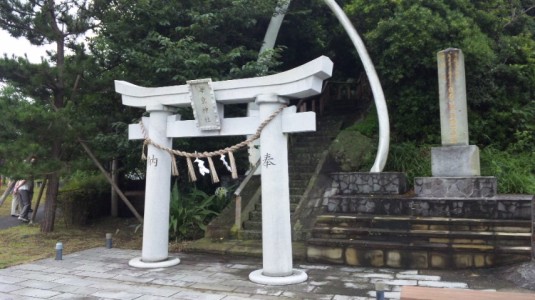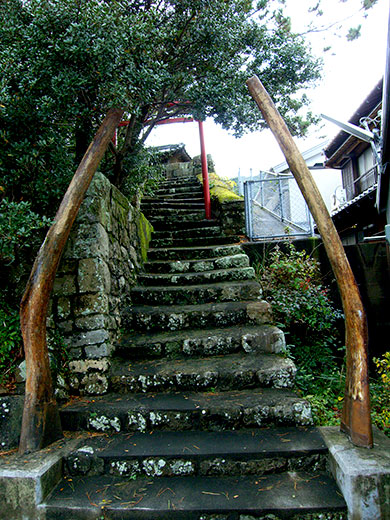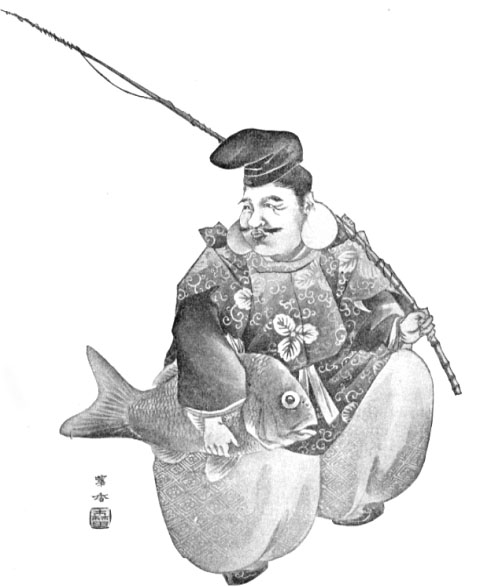Japan has acquired an ugly reputation for its duplicitous, cruel and government-subsidised whale hunting, together with the subsequent feeding of contaminated meat to schoolchildren and others. Australia has currently taken it to the world court about the ludicrous claim to be engaged in ‘scientific research’.
That Japan should be hell-bent on slaughtering the creatures, sometimes involving mothers with cubs and sometimes inflicting appallingly drawn-out deaths, is ironic given that in the past whales have been regarded as kami or associated with the divine.
On the excellent Huyakumonogatari Kaidankai website, Zach Davison has compiled a fine overview of whale folklore down the centuries. What follows below is an extract; for the full article, click here.
***********************************************
The Drifting Ashore God
In pre-seafaring Japan—before Samurai William brought the secret of keels and ocean-going vessels—fishermen were limited to the coastal waters their small ships could take them too. They eked out a subsistence living harvesting what was in reach. But every now and then, the oceans would deliver a bounty beyond imagination.
Whales would sometimes come inland, or beach themselves on the shore. Fishermen hunted these whales in a practice called Passive Whaling, using harpoons to kill the whale that was trapped in the shallows. This was a rare and auspicious event—a single whale provided vast amounts of meat and resources for the village, and seemed like a gift from the gods. And the whale itself was only a piece of the bounty. Whales often came in following larges schools of fish, so their arrival meant an abundance of sea life beyond the leviathan itself. The arrival of a whale could save a village teetering on the edge of starvation and ruin. It was manna from the oceans.
Like modern Cargo Cults, the villagers could not understand from where or why the whale came in to shore. They only knew that a whale meant wealth and rare full stomachs. Whales were considered to be embodied deities (shintai), and whale religions sprang up in coastal villages, called Hyochakushin (Drifting Ashore God) or Yorikami Shinkyo (The Religion of the Visiting Kami).
The Whale and Ebisu
These original whale cults were primitive. The people praying generally had one request—send more whales. But in time they evolved. Like many religions, the Whale Cults in Japan were built on a portion of respect and gratitude and a portion of fear. Because whaling—even Passive Whaling—was a dangerous operation, some whale religions also saw in whales the ability to be malevolent gods, and prayed to appease their spirits and assuage their wrath. Bad storms of poor catches could mean an angry whale god, and nobody wanted that.
In time, these whale religions merged with another, more popular deity, the god of abundance Ebisu. Whales were first thought to be emissaries of Ebisu, and then became considered to be an incarnation of Ebisu himself. Because whales were thought to have the power to control fish, fishermen began carrying images of the god Ebisu as a whale to give them the same fish-controlling powers.
Kujira Jinjya – Whale Shrines
When you have feasted on the body of a god, it only makes sense to give the leftovers a proper burial. After stripping the body of everything useful, villagers buried the whale carcass in mounds called Kujira Tsuga (whale mounds). Kujira Tsuga were capped with monuments of some sort, varying from carved stone tablets to pagodas to small wooden or rock shrines. Often these Kujira Tsuga were created in memory of some particularly bountiful harvest, and annual festivals where held like the Daihyo Tsuifuku (Big Catch Memorial Service). Or people prayed to the Kujira Tsuga for Kaijyo Anzen Kito (Prayers to Ensure Safety at Sea).
Places where passive whaling was more prevalent also had Kujira Haka (whale graveyards) and Kujira Ishibumi (whale stone monuments). There are about 100 known whale graveyards throughout Japan.
Many Kujira Tsuga have their own legends and myths. In Miyagi prefecture, Kesenmema city, Karakuwa town, a legend is told of a ship foundering in the storm that was approached by two massive, white whales. The two whales swam to either side of the ship and steadied it, guiding it into port before sailing away. From that day forward, the citizens of Karakuwa down abandoned their ancient custom of whale eating.
The legend is attached to the MIsaki Shrine in Karakuwa, but the connection is not exactly accurate. Misaki Shrine is an old Kujira Tsuga, raised over a whale corpse and topped with a stone monument expressing gratitude for the whale’s death.
In Ehime prefecture, Seiyo city, Akehama town there are three known Kujira Tsuga, one of which is high up in the mountains. The shrine is ancient, and overlooks the ocean. It now sits along the national highway route making it much more accessible. Hauling up that carcass must have been quite the event.
On June 21st, 1837 (Tenpo 8th), a massive whale came to shore directly underneath this shrine. This was during the Great Tenpo Famine, and the whale saved the entire area from starvation. The villagers gave the whale a posthumous Buddhist name, meaning roughly “The Great Whale Scholar of the Universe who Brings Health.” That was extremely rare at the time, as posthumous Buddhist names was an honor reserved for great lords. The shrine is still honored by the villagers today
Whalebone Torii Gates
By the Edo period, Japan had become a seafaring nation and created a whaling industry and culture. Whaling Associations established and maintained official Whale Shrines in coastal areas, many of which still exist today. Whale shrines were also built in Taiwan when it was under Japanese rule, usually dedicated to Ebisu.
The most dramatic of these have Whalebone Torii gates—the picturesque post-and-lintel design that signifies the presence of a kami spirit.. The oldest Whalebone Torii is in Wakayama prefecture, Taijicho town, called the Arch of Ebisu. Ihara Saikaku mentions this Tori in his book Nippon Eitaigura (Japan’s Warehouse of Eternity; 1688). The torii is probably much older, however. The newest whalebone tori is in Nagasaki, Shinkamigostocho town at the Kaido Jinjya (Shrine of the Sea). Dedicated in 1973, it was built by the Japan Whaling Association.




Thanks for the comments, gentlemen. My position as a vegetarian is that I’m against any form of cruelty to animals, particularly factory farming. Funnily enough, I’m not against hunting for food, as that seems a part of nature and animals are able to lead a free life up to the point of (a hopefully humane) death. In shamanic societies it made perfect sense to pray for the repose of the dead animal, or to its Great Spirit, but in the modern world we’ve moved away from a direct relationship to killing to one in which the living creatures are objectified as commodities. So my feeling is that while whale shrines made perfect sense in the past, they are not applicable to today’s cold-bloodied realities. Killing the whale is no longer necessary, nor are we dependent on it for our well-being as in a previous age. Times change, and so must religions… Buddhism teaches compassion for animals, and I would like Shinto to share in that ethic.